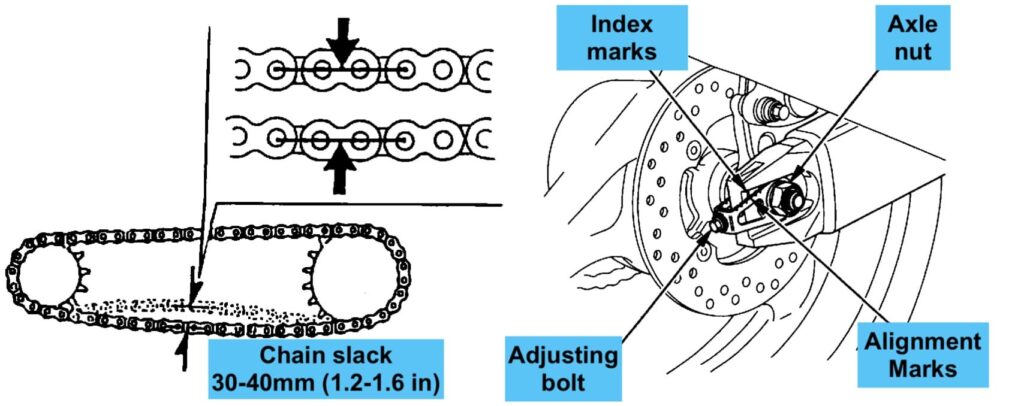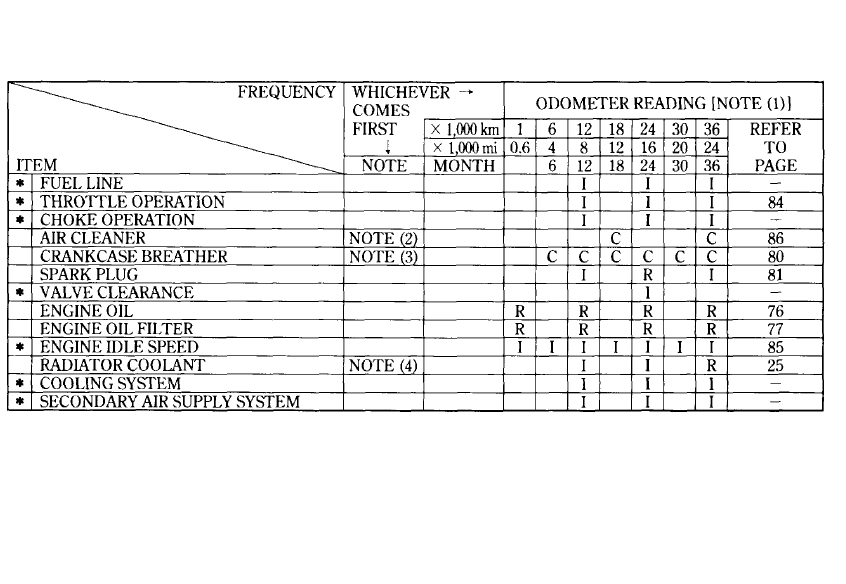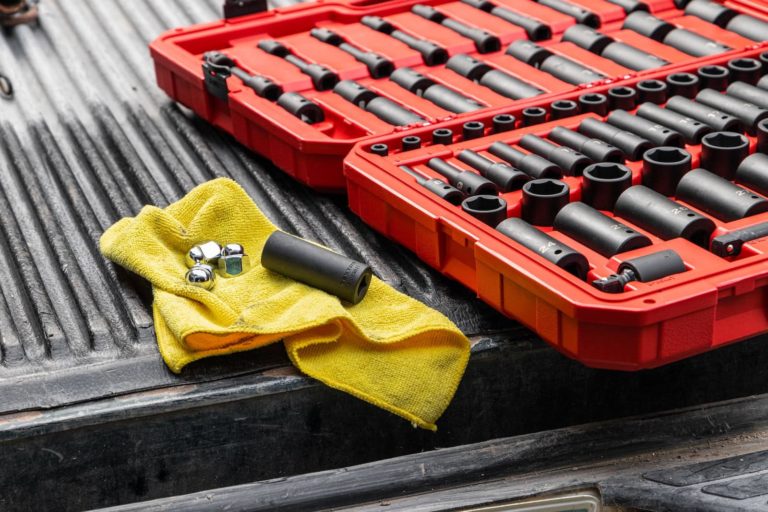Honda CB900F (919, Hornet 900, 2002-2007) Maintenance Schedule and Service Intervals
This is the maintenance schedule and associated service intervals for the Honda CB900F, also known as Honda CB900 Hornet or Hornet 919.
The Honda CB900F is one of those rare, perfectly balanced motorcycles that everyone is pleasantly surprised by. It’s purportedly a naked fuel-injected Honda FireBlade, re-tuned for mid-range performance and, but still sporty in every way — but the end result is a bike that can do anything and is hard to ride badly, but ends up begging for more all the time.
Maintenance on the CB900F Hornet is a doddle, as it has a fully-exposed inline four-cylinder engine with many interchangeable parts with other Hondas.
The CB900F was eventually replaced by the first generation of Honda CB1000R in 2008.
Updated in Oct 2023: Guidance on checking and adjusting the chain tension, plus more information on servicing the valves.
This site has links for things like oil and spark plugs from which we earn a commission (which unfortunately nobody can save, not even us). If you appreciate this work, then please use those links. Thanks!
Honda CB900F Hornet / Honda 919 Service Intervals
Overall, the Honda CB900F / Honda 919 has 8 000 mile / 12 000 km service intervals, at which point you change the oil and filter, and do a one-over inspection of the motorcycle. But Honda also recommends you more frequently inspect some items, like the brake system, and checking the engine idle speed.
Every 16 000 miles / 24 000 km, change the spark plugs and inspect / adjust the valve clearances. (There’s information on the valve service below.)
Honda recommends you replace spark radiator coolant and brake fluid every two years.
Aside from that, also make sure you regularly maintain the chain and other safety equipment.
What you need to service a Honda Hornet 900 (Honda 919)
To service your Honda 919, aside from basic motorcycle maintenance tools, you need the following consumables.
| Product | Honda 919 / Hornet 900 spec |
|---|---|
| Engine oil | Honda recommends SAE 10W-30 oil that is JASO T 903 MA rated that are not “energy conserving” or that have molybdenum additives, as these may affect clutch operation. Honda recommends Pro Honda GN4 10W-30 oil. Tighten the drain plug to 29 Nm (22 ft-lb). |
| Oil filter | Use a HifloFiltro HF204RC filter, which is an affordable and high-quality drop-in replacement. Tighten the filter to 26 Nm (20 ft-lb). |
| Spark plug | Use a NGK CR8EH-9 or Denso U24FER9 for most applications. The spark plug gap should be 0.80-0.90 mm (0.031 – 0.035 in). |
| Air filter | Use a K&N HA-9002 air filter. |
| Coolant | Honda recommends using Honda Coolant. |
| Brake fluid | Honda recommends Honda DOT 4 brake fluid. |
| Brake pads | Use EBC FA187HH at the front (two pairs), and FA174HH at the rear |
| Chain Maintenance | Use Motul chain paste, a convenient and inexpensive chain lube. |
| General lubricant | Use a lithium soap-based grease for external lubrication. |
| Cables | Lubricate cables with Protect All Cable Life, a well-liked cable lube. |
Honda 919 (CB900F Hornet 900) Maintenance Schedule
Below is the maintenance schedule for the Honda CB900F, a.k.a. the Honda Hornet 900 or the Honda 919. It’s reformatted for ease of use, separating out inspections from the major items (like oil changes).
Notes:
- At higher odometer readings, repeat at the frequency interval established here.
- Honda recommends many you get some maintenance, including coolant changes, valve clearance checks, and steering head bearing maintenance, done by a qualified mechanic.
- The break-in service is omitted as this bike is no longer in production.
| mi x 1000 | 4 | 8 | 12 | 16 | 20 | 24 | |
|---|---|---|---|---|---|---|---|
| km x 1000 | 6 | 12 | 18 | 24 | 30 | 36 | Every |
| Inspection checklist (see below) — Perform | ✓ | ✓ | ✓ | Year | |||
| Engine Oil — Replace (Pro Honda GN4 10W-30) | ✓ | ✓ | ✓ | Year | |||
| Engine Oil Filter — Replace (HF204RC) | ✓ | ✓ | ✓ | Year | |||
| Air Cleaner — Clean / Replace as needed (HA-9002) | ✓ | ✓ | More often if riding in dusty / wet areas. | ||||
| Spark Plug — Inspect / (R)eplace (CR8EH-9) | ✓ | R | ✓ | ||||
| Valve Clearance — Inspect / Adjust | ✓ | ||||||
| Engine Idle Speed — Inspect | ✓ | ✓ | ✓ | ✓ | ✓ | ✓ | 6 months |
| Radiator Coolant — Replace (Honda Coolant) | ✓ | 2 years: R | |||||
| Brake Fluid — Inspect level, (R)eplace (Honda DOT 4) | ✓ | ✓ | R | ✓ | ✓ | R | 2 years: R |
| Crankcase Breather — Clean | ✓ | ✓ | ✓ | ✓ | ✓ | ✓ | More often when riding in rain / at full throttle. |
Standard Inspection Checklist
Perform this standard inspection checklist per the maintenance schedule.
| Standard inspection checklist |
|---|
| Fuel Line — Check for correct routing, condition |
| Throttle Operation — Check free play (2-6mm), smooth operation |
| Choke Operation — Check that choke works |
| Cooling System — Inspect condition, coolant level |
| Drive Chain Slider — Check for wear |
| Brake System — Check for correct function |
| Brake Light Switch — Check that lights are triggered |
| Brake Pad Wear — Check that minimum wear is above 1mm |
| Headlight Aim — Check aim is correct when sitting on bike |
| Clutch System — Check correct operation |
| Side Stand — Check operation, lubricate as needed |
| Steering Head Bearings — Check for smooth operation |
| Suspension — Check for wear, leaks, smooth operation |
| Nuts, Bolts, Fasteners — Inspect for tightness |
| Wheels/Tires — Inspect for damage, wear |
| Secondary Air Supply System |
Maintaining Your Chain on the Honda CB900 / 919
It’s important to maintain your chain on the 919, as on any chain-driven motorcycle. Use a good-quality chain lubricant like Motul chain paste, or a Motul chain care kit which comes with a couple of handy tools to maintain the chain.
Honda recommends you follow the following chain maintenance schedule:
| Chain maintenance item | Every |
|---|---|
| Check drive chain lubrication condition, lubricating if necessary | 600 mi / 1000 km |
| Check drive chain slack, adjusting if necessary (See below notes) | 600 mi / 1000 km |
Notes:
- Do these items (checking/adjusting slack, and checking/applying lubrication) more often if you ride your 919 in dusty or rainy conditions.
- Always lubricate the chain after washing the motorcycle.
Checking chain slack
To check the slack on the Honda CB900F / 919 Hornet, put it motorcycle in neutral, onto its kickstand, and make sure that it’s on a level surface.
Check the slack on the lower part of the chain, midway between the sprockets, and check it in multiple places (move the motorcycle forwards and backwards) as chains wear unevenly. You can see the chain move around as you push the bike around.

Slack on the Honda CB900F is defined as the free vertical movement of the chain.
Target chain slack for the Honda CB900F / Hornet 919: 30 – 40 mm (1.2 – 1.6 in)
If the chain slack is out of spec, you need to adjust it.
Adjusting chain slack
To adjust the chain slack on the Honda CB900F / Hornet 919, follow the steps below.
As previously, make sure the bike is on a level surface, on its kickstand, with no luggage or other load.
- Loosen the rear axle nut. You may need a breaker bar to break it loose.
- Turn the adjuster nuts to tighten (or loosen) the chain. Clockwise loosens, and counter-clockwise tightens. Keep checking the chain tension to see if it has come within spec.
- Keep an eye on the adjuster alignment marks on either side of the axle. Make sure that the adjustment is to the same point.
- When you’re done, tighten the axle to 93 Nm / 69 lb-ft.
- Re-check the chain slack again to make sure it’s still within spec.
- Tighten the adjusting bolts lightly.
If the slack alignment markers make it to the red zone of the alignment marks, or if slack is more than 50mm and you can’t get it tighter, replace the chain.
Honda CB900F Valve Clearance Adjustment Notes
The Honda CB900F / Hornet 919 has a shim-under-bucket valve system. This means that to change the valve clearances, you have to disengage the cam chain tensioner, remove the camshafts, and remove the lifters, and remove the shims them, replacing them with shims of the appropriate thickness.
Thus, the valve service job is quite involved. Luckily, it’s within the grasp of the home mechanic, provided you have a service manual.
The manual specifies these valve clearances for the CB900F, reproduced here for easy reference. Check the valve clearances when the engine is cold.
- Intake: 0.16 mm (0.006 in)
- Exhaust: 0.25 mm (0.010 in)
Tyre Size and Tyre Pressure for the Honda CB900F
The Honda CB900F has the following tyre sizes standard, as well as the following recommended tyre pressures.
| Tyre | Size | Tyre pressure |
|---|---|---|
| Front | 120/70ZR17 M/C (58W) | 250 kPa (2.5 bar) 36 psi |
| Rear | 180/55ZR17 M/C (73W) | 290 kPa (2.9 bar) 42 psi |
Stock, the Honda CB900F shipped with Bridgestone BT56 or Michelin TX15/25 tyres, but you can fit any sport/sport touring tyres you like.
About the Honda CB900F / Hornet 919

The Honda CB900F is a naked standard sport bike based on the 919 cc engine from the 1998-1999 Honda CBR900RR FireBlade.
But the Honda CB900F — also known as the Honda 919 or the Honda Hornet 900 — is much more than a naked FireBlade. It’s also a lot less.
For one thing, the engine on the Hornet 900 is = fuel-injected. It’s the same basic 919 cc DOHC liquid-cooled 16-valve engine, but injectors mean that there’s less maintenance between seasons (no carburettors to clean out if they get gummed up).
The CB900F is also quite different stylistically. It has no fairings, obviously, and has that beautiful under-seat exhaust – now out of fashion for many practical reasons (they’re heavier and they can make the seat hot), but we enjoyed it while it lasted.
The suspension on the CB900F is, like on the Blade of generation on which it’s based, conventional (non-inverted). There are conventional forks up front that are non-adjustable, though they’re cartridge-style on the inside. And at the rear there’s a monoshock with a few settings for preload.
Brakes are pretty simple with Nissin four-pot calipers on the front gripping 296mm rotors. Nothing phenomenal, but enough to bring the CB900F’s 220 kg of wet weight to a standstill.
Where the CB900F is most obviously different to a FireBlade is, of course, the riding position. You’re much more upright, with more space in your knees and an easier reach to the handlebars.

But don’t be fooled! This is no docile commuter. The engine loves to rev, and makes its peak power of 81 kW (109 bhp) at a still reasonably high 9000 rpm.
The engine has been retuned for much more low-end torque, and the Honda 919’s torque peaks at a modest 6500 rpm, rather than the 10000 rpm seen on the ‘Blade. This makes the Honda CB900F much easier to ride around town. You can almost set it in a gear and forget it.
Nonetheless, the engine doesn’t feel boring. You can fling it up to 8000+ rpm and have a lot of fun with this motor.
The bars, too, are comfortable, but sporty. You still have a modest forward incline, and the bars are narrow enough to mean you have to push on them like you do with clip-ons.
Maintenance of the Honda CB900F is very easy, with pistons and spark plugs readily accessible. Major maintenances (valve clearance checks) are only every 16000 miles / 24000 km, much like on many Honda liquid-cooled motorcycles.
Manual for the Honda CB900F
The above maintenance schedule comes directly from the user’s manual for the Honda CB900F. See a screenshot of it below.

A copy of the manual is below.
You can also download manuals from Honda here.















